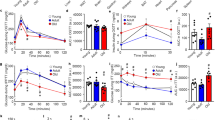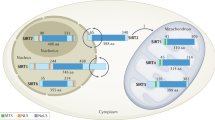Abstract
Calorie restriction extends lifespan and produces a metabolic profile desirable for treating diseases of ageing such as type 2 diabetes1,2. SIRT1, an NAD+-dependent deacetylase, is a principal modulator of pathways downstream of calorie restriction that produce beneficial effects on glucose homeostasis and insulin sensitivity3,4,5,6,7,8,9. Resveratrol, a polyphenolic SIRT1 activator, mimics the anti-ageing effects of calorie restriction in lower organisms and in mice fed a high-fat diet ameliorates insulin resistance, increases mitochondrial content, and prolongs survival10,11,12,13,14. Here we describe the identification and characterization of small molecule activators of SIRT1 that are structurally unrelated to, and 1,000-fold more potent than, resveratrol. These compounds bind to the SIRT1 enzyme–peptide substrate complex at an allosteric site amino-terminal to the catalytic domain and lower the Michaelis constant for acetylated substrates. In diet-induced obese and genetically obese mice, these compounds improve insulin sensitivity, lower plasma glucose, and increase mitochondrial capacity. In Zucker fa/fa rats, hyperinsulinaemic-euglycaemic clamp studies demonstrate that SIRT1 activators improve whole-body glucose homeostasis and insulin sensitivity in adipose tissue, skeletal muscle and liver. Thus, SIRT1 activation is a promising new therapeutic approach for treating diseases of ageing such as type 2 diabetes.
This is a preview of subscription content, access via your institution
Access options
Subscribe to this journal
Receive 51 print issues and online access
$199.00 per year
only $3.90 per issue
Buy this article
- Purchase on Springer Link
- Instant access to full article PDF
Prices may be subject to local taxes which are calculated during checkout




Similar content being viewed by others
References
Facchini, F. S., Hua, N., Abbasi, F. & Reaven, G. M. Insulin resistance as a predictor of age-related diseases. J. Clin. Endocrinol. Metab. 86, 3574–3578 (2001)
Barzilai, N., Banerjee, S., Hawkins, M., Chen, W. & Rossetti, L. Caloric restriction reverses hepatic insulin resistance in aging rats by decreasing visceral fat. J. Clin. Invest. 101, 1353–1361 (1998)
Bordone, L. & Guarente, L. Calorie restriction, SIRT1 and metabolism: understanding longevity. Nature Rev. Mol. Cell Biol. 6, 298–305 (2005)
Cohen, H. Y. et al. Calorie restriction promotes mammalian cell survival by inducing the SIRT1 deacetylase. Science 305, 390–392 (2004)
Heilbronn, L. K. et al. Glucose tolerance and skeletal muscle gene expression in response to alternate day fasting. Obes. Res. 13, 574–581 (2005)
Nisoli, E. et al. Calorie restriction promotes mitochondrial biogenesis by inducing the expression of eNOS. Science 310, 314–317 (2005)
Frye, R. A. Characterization of five human cDNAs with homology to the yeast SIR2 gene: Sir2-like proteins (sirtuins) metabolize NAD and may have protein ADP-ribosyltransferase activity. Biochem. Biophys. Res. Commun. 260, 273–279 (1999)
Frye, R. A. Phylogenetic classification of prokaryotic and eukaryotic Sir2-like proteins. Biochem. Biophys. Res. Commun. 273, 793–798 (2000)
Imai, S., Armstrong, C. M., Kaeberlein, M. & Guarente, L. Transcriptional silencing and longevity protein Sir2 is an NAD-dependent histone deacetylase. Nature 403, 795–800 (2000)
Baur, J. A. et al. Resveratrol improves health and survival of mice on a high-calorie diet. Nature 444, 337–342 (2006)
Howitz, K. T. et al. Small molecule activators of sirtuins extend Saccharomyces cerevisiae lifespan. Nature 425, 191–196 (2003)
Jarolim, S. et al. A novel assay for replicative lifespan in Saccharomyces cerevisiae . FEMS Yeast Res. 5, 169–177 (2004).
Lagouge, M. et al. Resveratrol improves mitochondrial function and protects against metabolic disease by activating SIRT1 and PGC-1α. Cell 127, 1109–1122 (2006)
Wood, J. G. et al. Sirtuin activators mimic caloric restriction and delay ageing in metazoans. Nature 430, 686–689 (2004)
Brink, C. B., Harvey, B. H., Bodenstein, J., Venter, D. P. & Oliver, D. W. Recent advances in drug action and therapeutics: relevance of novel concepts in G-protein-coupled receptor and signal transduction pharmacology. Br. J. Clin. Pharmacol. 57, 373–387 (2004)
Luo, J. et al. Negative control of p53 by Sir2α promotes cell survival under stress. Cell 107, 137–148 (2001)
Vaziri, H. et al. hSIR2(SIRT1) functions as an NAD-dependent p53 deacetylase. Cell 107, 149–159 (2001)
Napper, A. D. et al. Discovery of indoles as potent and selective inhibitors of the deacetylase SIRT1. J. Med. Chem. 48, 8045–8054 (2005)
Kaeberlein, M., McVey, M. & Guarente, L. The SIR2/3/4 complex and SIR2 alone promote longevity in Saccharomyces cerevisiae by two different mechanisms. Genes Dev. 13, 2570–2580 (1999)
Rogina, B. & Helfand, S. L. Sir2 mediates longevity in the fly through a pathway related to calorie restriction. Proc. Natl Acad. Sci. USA 101, 15998–16003 (2004)
Anderson, R. M., Bitterman, K. J., Wood, J. G., Medvedik, O. & Sinclair, D. A. Nicotinamide and PNC1 govern lifespan extension by calorie restriction in Saccharomyces cerevisiae . Nature 423, 181–185 (2003)
Lin, S. J., Defossez, P. A. & Guarente, L. Requirement of NAD and SIR2 for life-span extension by calorie restriction in Saccharomyces cerevisiae . Science 289, 2126–2128 (2000)
Sarabu, R. & Grimsby, J. Targeting glucokinase activation for the treatment of type 2 diabetes–a status review. Curr. Opin. Drug Discov. Dev. 8, 631–637 (2005)
Borra, M. T., Langer, M. R., Slama, J. T. & Denu, J. M. Substrate specificity and kinetic mechanism of the Sir2 family of NAD+-dependent histone/protein deacetylases. Biochemistry 43, 9877–9887 (2004)
Heilbronn, L. K. et al. Effect of 6-month calorie restriction on biomarkers of longevity, metabolic adaptation, and oxidative stress in overweight individuals: a randomized controlled trial. J. Am. Med. Assoc. 295, 1539–1548 (2006)
Rodgers, J. T. et al. Nutrient control of glucose homeostasis through a complex of PGC-1α and SIRT1. Nature 434, 113–118 (2005)
Rodgers, J. T. & Puigserver, P. Fasting-dependent glucose and lipid metabolic response through hepatic sirtuin 1. Proc. Natl Acad. Sci. USA 104, 12861–12866 (2007)
Banks, A. et al. Overexpression of the Sirtuin SIRT1 increases insulin sensitivity in aging mice. Diabetes 56 (S1), 0234-OR (2007).
Acknowledgements
We thank C. Ozbal and W. LaMarr from BioTrove, Inc. for running the mass spectrometry samples; S. Schaertl, D. Winkler, N. Fay and T. Hesterkamp for work on the SIRT1 fluorescence polarization assay development; M. Saberi, P. P. Li , M. Lu, and A. Hevener for assistance and advice with the Zucker fa/fa studies; P. Romero, K. Normington, and M. Dipp for experimental advice and comments on the manuscript; M. Inghilterra for help in data analysis and data mining. D.A.S. is supported by an Ellison Medical Foundation Senior Scholarship, and grants from NIH/NIA and the Paul F. Glenn Medical Foundation. J.M.O. is supported by a University of California Discovery Biostar grant and NIH. S.S. is supported by a Mentor-Based Postdoctoral Fellowship from the American Diabetes Association awarded to J.M.O.
Author information
Authors and Affiliations
Corresponding author
Ethics declarations
Competing interests
All authors declare competing financial interests except for S.S. All authors except for S.S., J.M.O. and D.S. are employees of Sirtris Pharmaceuticals. D.S. is a co-founder, Board member and consultant to Sirtris Pharmaceuticals. J.M.O. is a consultant to Sirtris Pharmaceuticals. Sirtris is a company whose goal is to develop drugs to treat age-related diseases.
Supplementary information
Supplementary Methods
The file contains Supplementary Methods with additional references. (PDF 218 kb)
Rights and permissions
About this article
Cite this article
Milne, J., Lambert, P., Schenk, S. et al. Small molecule activators of SIRT1 as therapeutics for the treatment of type 2 diabetes. Nature 450, 712–716 (2007). https://doi.org/10.1038/nature06261
Received:
Accepted:
Published:
Issue Date:
DOI: https://doi.org/10.1038/nature06261
This article is cited by
-
Treatment with recombinant Sirt1 rewires the cardiac lipidome and rescues diabetes-related metabolic cardiomyopathy
Cardiovascular Diabetology (2023)
-
GMMAD: a comprehensive database of human gut microbial metabolite associations with diseases
BMC Genomics (2023)
-
Alpha-glucosidase inhibitory activities of astilbin contained in Bauhinia strychnifolia Craib. stems: an investigation by in silico and in vitro studies
BMC Complementary Medicine and Therapies (2023)
-
Epigenetic regulation in metabolic diseases: mechanisms and advances in clinical study
Signal Transduction and Targeted Therapy (2023)
-
Mitochondria as a target for exercise-mitigated type 2 diabetes
Journal of Molecular Histology (2023)
Comments
By submitting a comment you agree to abide by our Terms and Community Guidelines. If you find something abusive or that does not comply with our terms or guidelines please flag it as inappropriate.



